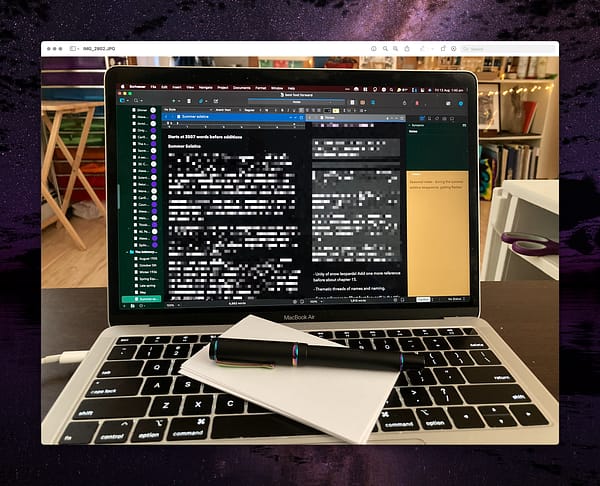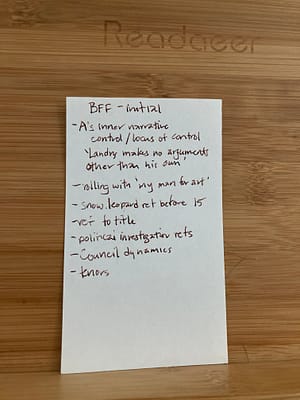I’m currently in the editing process for Best Foot Forward, and thought you might find a glimpse into the process interesting.
I do most of my writing on the desktop that lives in my bedroom. However, I do most of my editing on the laptop that lives in the living room, which has fewer distractions.
Here’s a shot of what that looks like. Read on for a description of both the image and the process.

On the screen: my editing setup
What you’re seeing is a shot of my computer, with Scrivener open, and the text mostly blurred.
The left sidebar is the list of files. In this case, this is the end of Best Foot Forward, then the epilogue novella, Intimacies of the Seasons (which will be included with the novel). The point of view character is indicated by the dot at the right of each file. In this case, purple for Alexander, and grey for Carillon. (My colour choices vary on the book and my mood when I set it up. I default to blue and yellow because they show up well, but sometimes I’ll use house colours like I did here.)
The left side of the main window is the working text of the chapter. The right side is the file with my running notes for the entire book. The top of the right sidebar, in dark green, is the synopsis, where I put my notes for the outline. This chapter didn’t happen to have any because the epilogue grew organically. The golden yellow area at the bottom right is the notes for this specific chapter, and it says “Seasonal notes – during the summer solstice sequence, getting flashes”. I’ll talk about the other text in a minute.
On top of the keyboard are my fancy fountain pen (which I love but don’t use often enough) and index cards. (The pen is a Conklin Duragraph in Matte Black/Rainbow. As you’ll see in a second, it has the Diamine Ancient Copper ink in it.)
The process, in brief
I always have a book in four different stages, on a three month cycle.
- Thinking about the next book
- Writing a book
- Letting a book sit
- Editing the book and getting it ready for publication
This keeps me busy, but it’s been working reliably for me.
I outline in Scrivener, a widely used writing app that allows you to create subfiles you can easily rearrange, along with supplemental information. My outlines start with somewhere between a sentence and a couple of short paragraphs for each chapter, and I write linearly.
Usually, I write in 4thewords.com, a writing gamification site. (I find “let me just finish fighting this monster by writing another 100 words” very motivating sometimes.) When I finish a chapter, it goes to Kiya, my friend, editor, and first reader.
Next, I drop the chapter into Scrivener (where my working draft lives), which has a notes field for each chapter. I add whatever notes I want to remember for later, comments Kiya had about things to bring out later, and anything else that strikes me. Any notes about the book as a whole go into my notes file in Scrivener so I remember larger things to revisit in the book.
When I finish a draft, I add any last notes to the main notes file, and then I set it aside for three months. I’ve found this lets my brain think about larger structure in the book, figure out where I might want to bring out something earlier, add more details, or all sorts of other things that make the book better.
Editing
I start the editing process by reading through the whole book. I clean up typos and minor issues as I see them, but I’m not focusing on that just yet. Instead, I’m looking for where the book needs more attention. Often this is smoothing out an arc, bringing out something that’s got a particular resonance, or digging a little more into the worldbuilding. Getting things more out of my head and visibly on the page is often necessary.
As I go, I make notes in that Scrivener notes file, roughly in chapter order. I might add a note to bring something out sooner.
(For example, in the shot above, I’ve blurred most of the text, but you can see “Unity of snow leopards! Add one more reference before about chapter 15.” and “Thematic threads of names and naming.” in the notes file.)
The first comment was because I’d ended up with two references to a snow leopard story that involves Benton and Carillon on their earlier adventures. You can’t just have two references to something like that, it needs three to be satisfying. The second one is a larger thematic question. I wanted to find a few more places to bring out the importance of names earlier in the book.
Working through the book
Once I’ve done a full reading pass, I organise the notes file so that I can see what changes I need to make chapter by chapter. I also write up notes on an index card for larger thematic questions that don’t fit in any one chapter, but where I’ll be making usually small adjustements to make them more visible or clearer or better woven into the larger story.
That looks like this. (There are no direct spoilers here.)

As you can see, these are brief, just enough to help remind me of what I wanted to pull together more. The text reads:
BFF – Initial
- A’s inner narrative
control / locus of control
‘Landry makes no arguments other than his own.’ - rolling with ‘my man for art’
- snow leopard ref before 15
- ref to title
- political investigation refs
- Council dynamics
- tenors
Mechanical editing
Once I’ve got the overall editing of the story where I want it, I run the whole thing through ProWritingAid. That’s a computer writing tool that checks for grammar and spelling. It also has tools for things like internal consistency, length of sentences, and a bunch of house rules I’ve set up for phrases I tend to overuse.
For example, this led me to comment in a Tweet when I was working on this, “Alexander, I know you are impassioned about the [spoiler], but you may not have a sentence 55 words long.”
It’s great for the things computers are good at fixing. I ignore quite a lot of the grammar suggestions for various reasons. Sometimes it got very confused. Other times, the suggestion doesn’t fit the period. (ProWritingAid keeps making helpful suggestions about gender neutral phrasing for different professions, and it is still the 1930s.)
Why the consistency check?
As my bio mentions, I was born and raised near Boston, Massachusetts. However, my parents are British. I grew up swapping between British and American English routinely and often without really noticing.
These days, I do almost all my creative writing in British mode, but there are still places where I haven’t entirely internalised a British spelling or my brain just slipped in the moment. (Medieval, for example. I was a Medieval and Renaissance Studies major in college, and have thus written the word a vast number of times in American, rather than the British mediaeval.) The consistency check helps me catch any that slipped through.
New sets of eyes
At this point, it goes off to Kiya, and we usually have two or three rounds of comments and revisions. This is our next step for Best Foot Forward. Kiya’s known me for a long time (we usually date being close friends to the spring of 1996). I blanket accept a lot of suggestions, and maybe change a few words on longer phrases or sentences. We might talk about a few specific passages in more detail, or I may chew on it for a little and suggest something.
My early readers are the best
Once we’ve done all that, it goes to my early readers, a small group of much appreciated friends. They read, comment, and most importantly let me know if something doesn’t make sense. I get a lot out of knowing what works well for them and excites them. And of course, from their wide range of experiences and sometimes quite specialist bits of knowledge.
We mostly do this in a Google Doc, so they can see each other’s comments, plus whatever comments I leave in before sharing it. Sometimes that leads to great things!
Best Foot Forward exists because Kiya made a comment when we were editing Eclipse (in chapter 14, when Alexander and Isembard are talking about munitions) that said, “I now sort of want the buddy cop story in which Alexander and Carillon team up to utterly destroy a munitions smuggler.”
That got me a comment thread of people wondering how they could encourage this to happen. Best Foot Forward is not a buddy cop story, but we think you’ll find it delightful!
